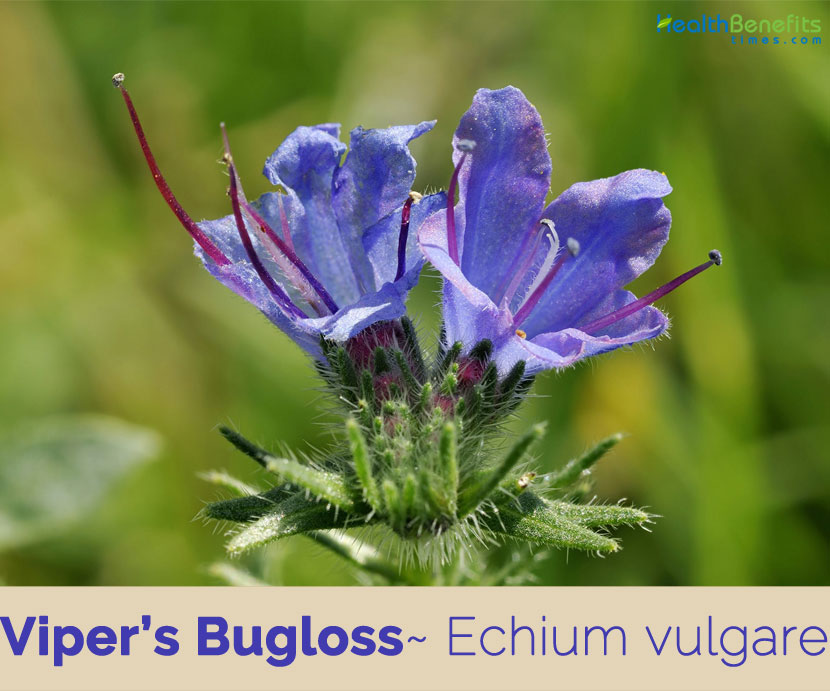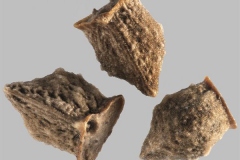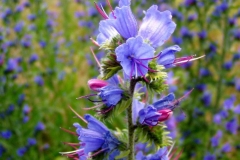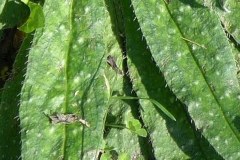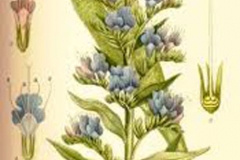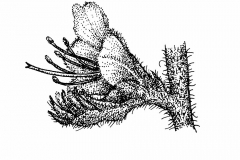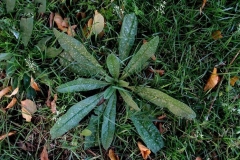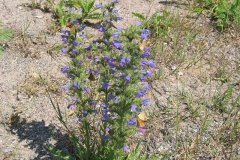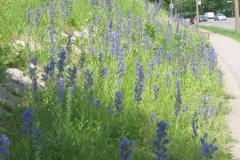| Viper’s Bugloss (Blueweed) Quick Facts | |
|---|---|
| Name: | Viper’s Bugloss (Blueweed) |
| Scientific Name: | Echium vulgare |
| Origin | Europe and western and central Asia and it occurs as an introduced species in north-eastern North America |
| Colors | Brown or gray |
| Shapes | Cluster of four seeds (i.e. nutlets or mericarps) that are enclosed by five bristly bracts |
| Health benefits | Beneficial for fevers, headaches, chest conditions, whitlows, boils, snake or viper bites, cracked hands and heal wounds |
| Name | Viper’s Bugloss |
|---|---|
| Scientific Name | Echium vulgare |
| Native | Most of Europe and western and central Asia, and it occurs as an introduced species in north-eastern North America |
| Common Names | Blueweed, Blue echium, Blue thistle, Blue-devil, Common echium, Common viper’s bugloss, Common vipersbugloss, Viper’s-bugloss, Vipers bugloss, Blue devil |
| Name in Other Languages | Afrikaans: Blueweed, Blou-echium Albanian: Blueweed, Ushqerza e rëndomtë, ushqerëz Amharic: Semayawī (ሰማያዊ) Arabic: bulyud (بلوويد), akhiun (أخيون) Armenian: Kapuyt (կապույտ), Izhakhot sovorakan (Իժախոտ սովորական) Azerbaijani: Göyərti Basque: Sugegorri-belar Belarusian: Siniak zvyčajny (Сіняк звычайны), Siniakviet zvyčajny (Сіняквет звычайны), kuchi ezik obiknoven (кучи език обикновен), obiknoveno usoĭniche (обикновено усойниче) Bengali: Blueweed Bulgarian: Blueweed, Obiknoveno usoĭniche (Обикновено усойниче) Burmese: Hkyitsuu (ချစ်သူ) Catalan: Bolenga borda, Borratja borda, Cul de porc, Herba viborera, Viperina, llengua de bou, herba del vibre, llengua de bou vulgar Chinese: Lán cǎo (蓝草), Lan Ji (蓝蓟) Corsican: Viparina turchina Croatian: Blueweed, obična lisičina Czech: Blueweed, Hadinec obecný Danish: Blueweed, Almindelig slangehoved, Læge-Kvæsurt, Slangehoved Dutch: Blauwkruid, Slangenkruid, gewoon slangekruid English: Blueweed, Blue echium, Blue thistle, Blue-devil, Common echium, Common viper’s bugloss, Common vipersbugloss, Viper’s-bugloss, Vipers bugloss, Blue devil Esperanto: Blueweed Estonian: Sinikas, Harilik ussikeel, Ussikeel Filipino: Blueweed Finnish: Blueweed, Punaluppio, Kyläneidonkieli, neidonkieli French: Blueweed, Vipérine commune, Vipérine, Vipérine vulgaire, bouquet bleu, herbe aux vipers, herbe bleue, herbe piquante, langue d’oie, Vipérine vulgaire , buglosse sauvage Georgian: Blueweed, lurji dzirts’itela (ლურჯი ძირწითელა) German: Blueweed, Gemeiner Natterkopf, Gewöhnlicher Natterkopf, Gewöhnlicher Natternkopf, buglosse sauvage, Greek: Ble (μπλε ) Gujarati: Bluviḍa (બ્લુવિડ) Hausa: Blueweed Hebrew: כחול-כחול Hindi: Blueweed Hungarian: Blueweed, Kígyószisz, terjőke kígyószisz, közönséges kígyószisz Icelandic: Bláleitur Indonesian: Blueweed Irish: Blueweed, Lus nathrach Italian: Blueweed, Erba viperina, Viperina azzurra, echio commune, erba delle vipere, erba rogna, lingua di bove, viperina azzurra, viperina commune, Japanese: Burūu~īdo (ブルーウィード), Shibenagamurasaki (シベナガムラサキ) Javanese: Blueweed Kannada: Blūvīḍ (ಬ್ಲೂವೀಡ್) Kashubian: Zwëczajny mòdrzińc Kazakh: Kökşil (көкшіл) Korean: Haecho (해초) Kurdish: Blueweed Lao: Khi ai (ຂີ້ອາຍ) Latin: Blueweed Latvian: Zilganzaļa, parastais daglītis Lithuanian: Mėlynė, Paprastasis ežeinis Macedonian: Sino (сино), Volchǰa opashka (Волчја опашка) Malagasy: Blueweed Malay: Blueweed Malayalam: Blūvīḍ (ബ്ലൂവീഡ്) Maltese: Blu Marathi: Bloo veed (ब्लूवीड) Mongolian: Khökhrökh (хөхрөх) Nepali: Nilōvīḍa (निलोवीड) Norwegian: Blueweed, Blodtopp, Ulvegab, Vargflab, Ormehode, Ormehovud Occitan: Bourrage-fèr, Suçamèlo Oriya: ବ୍ଲୁୱିଡ୍ Ossetian: Uox (Уохъ) Pashto: نیليویډ Persian: Blueweed, گل افعی رسمی Polish: Blueweed, Żmijowiec zwyczajny Portuguese: Blueweed, Colubrina, Suajos, erva-viperina, viperina, Borrago, Erva-azul, lingua-de-boi, soagem, viboreira, Punjabi: Nīlā (ਨੀਲਾ) Quechua: Llunku-llunku Romanian: Larba albastră, Iarba şarpelui, Iarba șarpelui, iarba-şearpelui Russian: Blueweed-ˈblo͞owēd, Sinyak obyknovennyy (Синяк обыкновенный) Serbian: Blueveed (блуевеед), lisichina (лисичина), obichna lisichina (обична лисичина) Sindhi: بليو ويڊ Sinhala: Blūvīḍ (බ්ලූවීඩ්) Slovak: Hadinec obyčajný Slovenian: Blueweed, navadni gadovec Spanish: Blueweed, Viborera, abalea, boninos, buglosa salvaje, buglosa, cardo, chupamiel, chupamieles, hierba azul, hierba de la víbora, hierba viborera, culebrera, hierba cerruda, lengua de gato, melera, viborera morada, viperina, manasa, ortiguilla, paraque tequiero Sundanese: Blueweed Swedish: Blueweed, Blodtopp, Gråpimpinell, Prunkhallon, Blåeld, Kyläneidonkieli, Blåtistel, Rävarompa, Rävasvans Tajik: Kaʙud (кабуд) Tamil: Puḷūvīṭ (புளூவீட்) Telugu: Blueweed-ˈblo͞owēd Thai: Blueweed-ˈblo͞owēd Turkish: Blueweed, Adi engerek out, engerek otu Ukranian: Blyuvotka (блювотка), Synyak zvychaynyy (Синяк звичайний) Upper Sorbian: Módry kosmač, Wšědna hrimanka Urdu: بلیو ویڈ Uzbek: Ko’katlar Vietnamese: Xanh Welsh: Blueweed, Gwiberlys Zulu: Oluhlaza okwesibhakabhaka |
| Plant Growth Habit | Upright, relatively long-lived biennial or monocarpic perennial herbaceous plant |
| Growing Climates | Roadsides, open waste and disturbed land, stony riverbeds, cliffs near the sea, on walls, old quarries, gravel pits, calcareous grassland and heaths, bare and waste places, railways, coastal cliffs, sand dunes and shingle, pastures, waterways, overgrazed pastures, gravel bars, moist upland forests |
| Soil | Often found in alkaline soils with a dolomite or limestone base material, although it can also be found in areas with more acidic soils. While blueweed exhibits a preference for sandy, well-drained soils, it does not do well in very arid regions |
| Plant Size | 30-60 cm tall, but occasionally reaching up to 1.2 m in height |
| Root | Significant rooting system comprised of a taproot and smaller fibrous roots. The taproot is black with a reddish cast, ranging in length from 12 to 32 inches (30.5 to 81cm) |
| Stem | Several upright stems is covered in coarse hairs (sometimes red at the base) and finer shorter hairs that arise from the base of the plant. These hairs can cause skin irritation if touched. |
| Leaf | Rosette leaves are long and narrow (5-15 cm long, 8-15 mm wide) but become shorter and narrower moving up the stem |
| Flowering season | July to October |
| Flower | Trumpet-shaped flowers, up to 12-15 mm long, are deep-blue. Each flower has five stamens, four of which protrude out of the flower tube whereas the fifth is included inside |
| Fruit Shape & Size | Cluster of four seeds (i.e. nutlets or mericarps) that are enclosed by five bristly bracts |
| Fruit Color | Greyish-brown |
| Propagation | By Seed |
| Plant Parts Used | Leaves, flowers, roots |
| Seed | Pale brown, 2-3.5 mm long and rough on the outside. Up to four seeds are produced from each flower |
| Season | August to October |
Plant Description
Viper’s Bugloss (Blueweed) is an upright, relatively long-lived biennial or monocarpic perennial herbaceous plant that normally grows about 30-60 cm tall, but occasionally reaching up to 1.2 m in height. The plant is found growing in roadsides, open waste and disturbed land, stony riverbeds, cliffs near the sea, on walls, old quarries, gravel pits, calcareous grassland and heaths, bare and waste places, railways, coastal cliffs, sand dunes and shingle, pastures, waterways, overgrazed pastures, gravel bars, moist upland forests. The plant is often found in alkaline soils with a dolomite or limestone base material, although it can also be found in areas with more acidic soils. While blueweed displays a preference for sandy, well-drained soils, it does not do well in very arid regions. The plant has significant rooting system comprised of a taproot and smaller fibrous roots. Taproot is black with a reddish cast, ranging in length from 12 to 32 inches (30.5 to 81 cm).
Stem
The upright and usually unbranched stems arise from a basal rosette of leaves. They are covered in short, stiff hairs and grow 30 – 80 cm tall. These stems are green in color and covered in stiff hairs or bristles. They generally have conspicuous dark flecks at the bases of some hairs. There may be one to several stems per plant.
Leaves
Plant consists of a low rosette of basal leaves spanning up to 1½ feet across, but during the final year one or more erect to ascending stems are produced that become 1–3¼ feet tall. Basal leaves are 3-9 inches long and ½–1¾ inches across. They are oblanceolate-oblong, oblanceolate-elliptic, or oblong-elliptic in shape, while their margins are entire, ciliate with stiff bristly hairs, and sometimes undulate (wavy up-and-down). Each central stem is pale grayish green, terete, and densely covered with stiff bristly hairs that have swollen purplish bases. Abundant alternate leaves occur along each stem, becoming gradually smaller as they ascend. These leaves are 1½–8 inches long, ¼–1½ inches across, and sessile. They are lanceolate-elliptic, lanceolate-oblong, or oblong-elliptic in shape, while their margins are entire, ciliate with stiff bristly hairs, and sometimes undulate (wavy up-and-down). The upper and lower surfaces of both basal and alternate leaves are yellowish green or grayish green, and they are covered with stiff bristly hairs that sometimes have swollen white bases. Both basal and alternate leaves have prominent central veins. All leaves are hairy on both surfaces.
Flowers
Stems terminate in inflorescences that are ½–2 feet long. They consist of spike-like racemes of short scorpioid cymes. The cymes are incurled like a scorpion’s tail, and they contain up to 20 flowers each. The sessile flowers are arranged along only one side of the cyme. Each flower is about ¾ inches across and 1 inch long, consisting of a deep blue or blue-violet corolla with 5 shallow lobes, 5 grayish green sepals, 5 stamens with reddish purple filaments, a slender white style with a divided tip, and a 4-lobed ovary. The large corolla is campanulate (bell-shaped), but longer above than below. The sepals are grayish green, linear-oblong in shape, and covered with stiff bristly hairs. Both the stamens and style are strongly exserted from the corolla. At the base of each cyme, there is a linear-lanceolate leafy bract up to 1 inch long that is grayish green and covered with stiff bristly hairs. The central stalk of the inflorescence has the same characteristics as the central stem. The blooming period occurs during the summer and early autumn, lasting 1-3 months. The plant is an insect attracting plant, including various bees, bumblebees and butterflies
Fruits
Fertile flowers are followed by a cluster of four seeds (i.e. nutlets or mericarps) that are enclosed by five bristly bracts (i.e. the persistent sepals). Seeds are 0.8-0.12 in. (2-3 mm) long and are greyish-brown in color woody, three-angled, and roughly textured (i.e. strongly wrinkled and pitted). The surface of the seed is rough and very hard. They are spread by the wind or humans and animals.
Traditional uses and benefits of Viper’s Bugloss (Blueweed)
- Eating the leaves is said to stimulate sexual desire.
- Viper’s bugloss was once considered to be a preventative and remedy for viper bites.
- Leaves and flowering stems are antitussive, aphrodisiac, demulcent, diaphoretic, diuretic, pectoral and vulnerary.
- An infusion of the plant is taken internally as a diuretic and in the treatment of fevers, headaches, chest conditions etc.
- Juice of the plant is an effective emollient for reddened and delicate skins; it is used as a poultice or plaster to treat boils and carbuncles.
- Roots contain the healing agent allantoin.
- The plant is said to be efficacious in the treatment of snake bites.
- When chopped up finely, the fresh flowering heads can be made into a poultice for treating whitlows and boils.
- Plant root was used in ancient times as a treatment for snake or viper bites.
- Seeds are also thought to resemble snake heads, thus specifying it as a cure for the bites of serpents.
- In poultices, the fresh leaves and flowers are apparently useful for getting rid of boils and hard skin.
- Leaves, especially those growing near the root, make a good cordial on infusion, which operates by perspiration and alleviates fevers, headaches and nervous complaints, relieving inflammatory pains.
- In Iran it has been used for centuries to stimulate the mood and as an aphrodisiac.
- Leaves and flowering tops are used in infusions and decoction for coughs and other respiratory problems and are also used to soften the skin and relieve inflammation and redness.
- The tisane can be used on wounds to speed healing and it has been found that the roots contain allantoin which is known to be a wound healer, so a poultice of decoction of the roots may be good for wounds.
- Freshly squeezed juice of the plant can be applied to reddened and irritated skin.
- As a poultice it helps against boils and abscesses.
- Juice of the plant is an effective emollient for reddened and delicate skins.
- The Viper’s bugloss is used in traditional folk medicine to treat cracked hands and heal wounds.
Culinary Uses
- Young leaves can be consumed raw or cooked.
- They can be used as a spinach substitute.
- Although somewhat hairy, when chopped up finely they are an acceptable part of a mixed salad.
- Flowers can be added to salad, crystallized or made into a cordial.
- Leaves are somewhat hairy, but when chopped up finely they are acceptable – young leaves taste mild and mucilaginous, can be eaten raw in a mixed salad/ or cooked and used as a spinach substitute.
Other Facts
- A red dye is obtained from the root.
- If eaten, the plant is toxic to horses and cattle through the accumulation of pyrrolizidine alkaloids in the liver.
- In some countries Echium is grown as an oilseed crop because of the fatty acid composition of the seed oil.
- Like Borage and Evening primrose oil, it contains significant amounts of gamma linolenic acid (GLA), and it also contains the rarer stearidonic acid.
- When young, the plants are highly palatable to sheep
- Plants produce from 500 to 2,000 seeds per plant.
References:
https://www.itis.gov/servlet/SingleRpt/SingleRpt?search_topic=TSN&search_value=31899#null
http://www.hear.org/pier/species/echium_vulgare.htm
https://npgsweb.ars-grin.gov/gringlobal/taxon/taxonomydetail?id=14879
https://pfaf.org/user/Plant.aspx?LatinName=Echium+vulgare
http://www.missouribotanicalgarden.org/PlantFinder/PlantFinderDetails.aspx?taxonid=277970
http://www.floracatalana.net/echium-vulgare-l
https://plants.usda.gov/core/profile?symbol=ECVU
https://en.wikipedia.org/wiki/Echium_vulgare
https://www.invasiveplantatlas.org/subject.html?sub=5564
https://profiles.ala.org.au/opus/weeds-australia/profile/Echium%20vulgare
http://www.theplantlist.org/tpl1.1/record/kew-2784423
https://keyserver.lucidcentral.org/weeds/data/media/Html/echium_vulgare.htm
https://gd.eppo.int/taxon/EHIVU
https://botanical.com/botanical/mgmh/b/bugvip85.html


